13-inch Retina MacBook Pro Review (Late 2012)
by Anand Lal Shimpi on November 13, 2012 2:53 AM ESTThermals & Acoustics
When we looked at the 15-inch rMBP we noted that it was a significant improvement in the thermal department compared to the previous, 2011 MacBook Pro. The move to 22nm Ivy Bridge and 28nm Kepler silicon meant a much better power profile than the outgoing model. Apple also changed the way it brings air through the system. The previous MacBook Pro chassis did all air exchanging through vents near the hinge of the machine. The new Retina systems pull in cool air from the sides and exhaust it at the display hinge.
In the 15-inch rMBP the improved cooling combined with more power efficient silicon helped ensure more consistent performance over time. While the 2011 15-inch MacBook Pro would quickly throttle under heavy CPU and GPU load, the 15-inch Retina MBP didn't have to reduce clock speeds as aggressively to keep the system's thermal footprint in check.
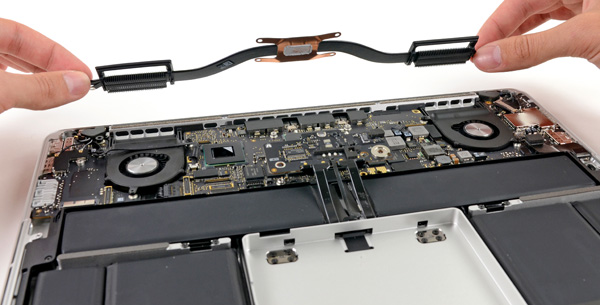
13-inch rMBP cooling solution, courtesy iFixit
With the 13-inch model, the cooling problem is far less of an issue. For starters, Apple only has to remove heat from a single major producer rather than two. There is no discrete GPU in the 13-inch rMBP, so the cooling workload is immediately reduced. Secondly, the 13-inch rMBP is only available with a dual-core 35W Ivy Bridge processor, and not the quad-core 45W parts used in the 15-inch model. With a cooler running CPU and no dGPU, the 13-inch rMBP has a much easier job of staying cool compared to the 15.
To confirm there was no obvious CPU throttling I ran two tests. The first was continuous runs of Cinebench 11.5's multithreaded render benchmark. Prolonged multithreaded FP workloads have always been a great way to drive temperatures up. We didn't see any throttling during this test on the 15-inch rMBP, and it's no surprise that we see no different here with the 13-inch model:
Next up, I ran the same type of test but using Half Life 2 instead. Here I picked settings that provided a good balance of CPU and GPU workload and ran back to back timedemos while monitoring performance:
As expected, there's no obvious drop in performance over time.
Apple also paid attention to acoustics with this generation. Like the 15-inch model, the 13-inch rMBP uses two fans to remove heat from a single heatpipe that runs across the CPU. The fan blades are asymmetrically spaced on each fan to produce a sound that's more varied across the frequency spectrum, rather than concentrated at specific frequencies. The idea is to create the illusion of quiet fans without negatively impacting cooling ability.
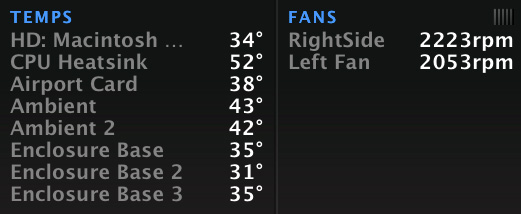
Even more so than in the 15-inch rMBP, Apple's fans in the 13-inch rMBP rarely spin above 2200 RPM. During both the Cinebench and Half Life 2 tests, fan speed remained around 2100 RPM. At these speeds, fan noise is effectively non-existent. In fact, during all of my testing of the 13-inch rMBP there were only a couple of times when I actually heard the fans spin significantly faster than that. Although I would like to see faster silicon and dGPU-level graphics performance in the 13, the obvious benefit of not having four cores and discrete graphics is a very quiet system.
Thermal performance goes hand in hand with acoustics of course. During the Half Life 2 marathon run I kept tabs on CPU and chassis temperature. The results are below:
| Thermal Comparison | ||||
| 13-inch rMBP | 15-inch rMBP | |||
| Max CPU Temp | 52C | 63C | ||
| Max GPU Temp | - | 72C | ||
| Max Surface Temperature (Top) | 48.1C | 49.8C | ||
| Max Surface Temperature (Bottom) | 41.6C | 41.8C | ||
Unfortunately I don't have a 2011 13-inch MacBook Pro to compare to, but the 13-inch rMBP is clearly cooler running than the 15. In terms of user experience, I felt the 13-inch rMBP get warm but never too hot to use on my lap.


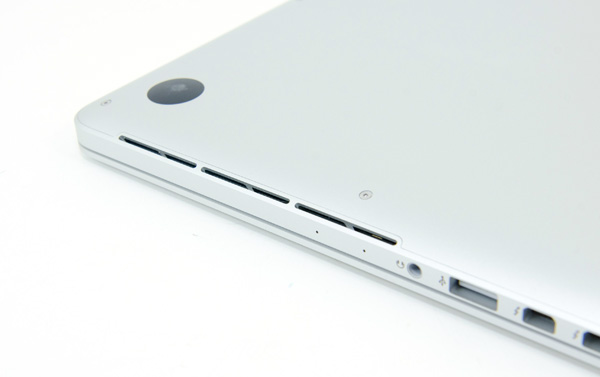
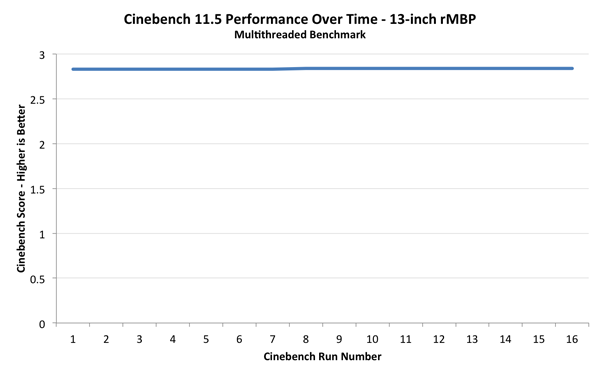
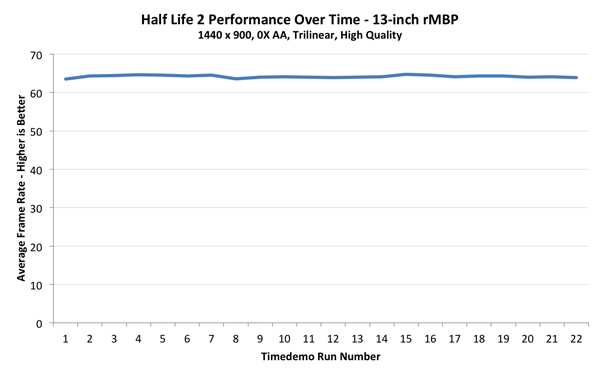








79 Comments
View All Comments
repoman27 - Tuesday, November 13, 2012 - link
And just to further clarify, Thunderbolt does not really mux DP and PCIe signals, it takes the packets from both protocols and transports them via a common switching fabric, so that wording is slightly misleading.tipoo - Tuesday, November 13, 2012 - link
In my time with these, I find there is just a bit of UI lag to most things compared to an Air or the regular Macbook Pros, most of the time it's hard to even notice unless they are side by side. The calender flip animation and sometimes the green button re-size are particularly painful, you can literally count out the frames on the former. On the 15" you can force it to use the dGPU on AC power which fixes that, but there is no fallback for the 13".tipoo - Tuesday, November 13, 2012 - link
Speaking of which, if switching to the dGPU fixes some of the lag does that mean more of the rendering pipeline is given to the Nvidia chip unlike the HD4000, as otherwise that would put a hole in the single threaded performance theory?sputnik78 - Tuesday, November 13, 2012 - link
"There's not much you can do here other than wait for faster hardware or buy the fastest CPU available on whatever system you're considering. "Yes there is. Use Firefox or Chrome.
I could not believe the depth of detail in the investigation of the scrolling in Safari issue without the simple test to swap out with Firefox or Chrome and see how much of the problem is Safari rather than the OS/Hardware.
With Firefox, you can enable and disable GPU accelerated UI as well, to see if that helps or hurts.
My experience with all three browsers is that each can have various performance issues with some websites and situations, but that when one does, one of the others tends to be OK.
MrCromulent - Tuesday, November 13, 2012 - link
Firefox doesn't even have Retina support yet, does it? Last time I heard it was planned for version 18.Disabling hardware acceleration in Firefox would probably just result in even worse performance since it is enabled by default and the CPU single-thread performance is going to get even more maxed out otherwise.
paravorheim - Tuesday, November 13, 2012 - link
Dear Anand,you mentioned in both the Intel S3700 and 13" rMBP reviews that OS X did not respond well to high IO latency. Could you expand on what you meant by that? Or is the explanation too complicated to put into layman's terms?
AmdInside - Tuesday, November 13, 2012 - link
I don't see how this is a much better option for someone who travels a lot and uses it mainly for typing. I love my MBA and only wish would be that it had more RAM and IPS display. If i had to do it all over again, I think I would still buy the MBA over the rMBP. If I had more money than I knew what to do with, I guess I'd go with the rMBP though.thefizzle656 - Tuesday, November 13, 2012 - link
IMO what is wrong with the 13" rMBP is not just that the word "Pro" doesn't at all describe the hardware specs and capabilities of the machine, but that it is so so overpriced for what you get. Even Apple Fanbois are have been criticizing Apple for the complete ripoff that the 13" rMBP is.spronkey - Tuesday, November 13, 2012 - link
You know, I have to agree with those who say there's a bit of Apple bias going on here. So many important criteria here have been glossed over - remember the pricing of this machine puts it far out of reach for most 'consumers', who go and buy $500-700 dell machines. It's a high-end part for a high-end prosumer/professional.The bottom line is - 8GB of RAM as a maximum ceiling (note - my *2008* MacBook Pro had the same limit) is far too low, and Anand you of all people should know that in the usable life of this machine (lets say 3 years), that limit is going to be hit - especially when it's not uncommon for web browsers with media-heavy content to eat 2+GB. And the move to 64-bit for stuff like the Adobe creative suite, which is a common use case for this particular machine, will eat even more RAM. I'm running 8GB on my MBP at the moment and I max it out very frequently.
I'm also not sure how you can recommend this over the 13" Air. It's much more expensive, the hardware is largley similar, performance isn't *that* much better, it doesn't offer anything in terms of upgradability other than Thunderbolt connectivity, and it's bigger and heavier. Not to mention in the real world, in 2012, it's a laggier experience.
Now, lets imagine an alternate universe where Apple decided not to shave quite so much off the size of the previous 13" pro, and instead gave us a quad core i5/i7 and a couple of RAM slots. Perhaps even a dedicated GPU and a 2.5" bay. Now that would be an improvement. What we have here is an expensive Macbook Air with a pretty display for text, that makes almost everything else look awful.
seapeople - Saturday, November 17, 2012 - link
When will we stop the insanity with this complaint about memory. Times are different, memory requirements are not going to quadruple again in the next four years. The world is not gearing up for Microsoft Gargantuan 9 which will require 8GB of RAM to load the desktop. If anything the world is going more mobile, and memory requirements will likely stagnate. Consider than an Ipad has just one GB of RAM, and they are selling about as many of those as casual consumer PC's nowadays, and you can see where we're heading.Furthermore, any browser worth its salt that's pushing 2GB of RAM based on some standard media heavy tasks will drop that RAM in an instant without a huge user experience impact if you start nearing a system limit. It's just caching everything in sight because it sees that you have 16 GB of RAM; it doesn't mean your system would grind to a halt with only 8!